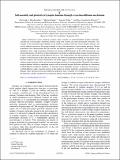Self-assembly and plasticity of synaptic domains through a reaction-diffusion mechanism
Author(s)
Haselwandter, Christoph A.; Kardar, Mehran; Triller, Antoine; da Silveira, Rava Azeredo
DownloadPhysRevE.92.032705.pdf (6.532Mb)
PUBLISHER_POLICY
Publisher Policy
Article is made available in accordance with the publisher's policy and may be subject to US copyright law. Please refer to the publisher's site for terms of use.
Terms of use
Metadata
Show full item recordAbstract
Signal transmission across chemical synapses relies crucially on neurotransmitter receptor molecules, concentrated in postsynaptic membrane domains along with scaffold and other postsynaptic molecules. The strength of the transmitted signal depends on the number of receptor molecules in postsynaptic domains, and activity-induced variation in the receptor number is one of the mechanisms of postsynaptic plasticity. Recent experiments have demonstrated that the reaction and diffusion properties of receptors and scaffolds at the membrane, alone, yield spontaneous formation of receptor-scaffold domains of the stable characteristic size observed in neurons. On the basis of these experiments we develop a model describing synaptic receptor domains in terms of the underlying reaction-diffusion processes. Our model predicts that the spontaneous formation of receptor-scaffold domains of the stable characteristic size observed in experiments depends on a few key reactions between receptors and scaffolds. Furthermore, our model suggests novel mechanisms for the alignment of pre- and postsynaptic domains and for short-term postsynaptic plasticity in receptor number. We predict that synaptic receptor domains localize in membrane regions with an increased receptor diffusion coefficient or a decreased scaffold diffusion coefficient. Similarly, we find that activity-dependent increases or decreases in receptor or scaffold diffusion yield a transient increase in the number of receptor molecules concentrated in postsynaptic domains. Thus, the proposed reaction-diffusion model puts forth a coherent set of biophysical mechanisms for the formation, stability, and plasticity of molecular domains on the postsynaptic membrane.
Date issued
2015-09Department
Massachusetts Institute of Technology. Department of PhysicsJournal
Physical Review E
Publisher
American Physical Society
Citation
Haselwandter, Christoph A., Mehran Kardar, Antoine Triller, and Rava Azeredo da Silveira. “Self-Assembly and Plasticity of Synaptic Domains through a Reaction-Diffusion Mechanism.” Phys. Rev. E 92, no. 3 (September 2015). © 2015 American Physical Society
Version: Final published version
ISSN
1539-3755
1550-2376